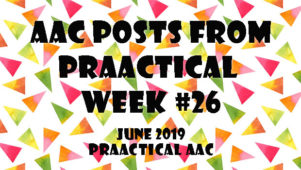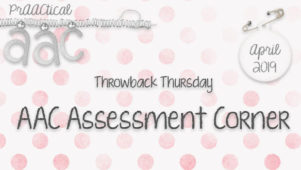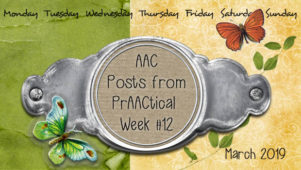Narrative Assessment and People who Use AAC
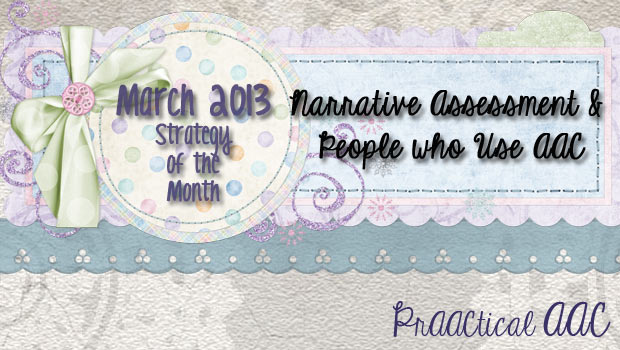
This month, we’ve been talking about building narrative skills in our AAC clients. We tried to build the case that including narrative language goals in our intervention allows us to help people who use AAC to participate more fully in social exchanges, relay more in-depth information, and achieve greater academic success. But how do we know where to start in narrative intervention? And how do we measure progress? In this post, we share some thoughts on the assessment of narrative language in AAC.
Most test batteries that assess narrative language are designed to take a snapshot of what the learner has already mastered in terms of telling personal narratives, story retelling, or scripts. This allows us to look beyond MLU, morphology, and grammar and can be useful in determining whether intervention is needed. Some scholars, however, have noted the limitations of this “one shot” approach, particularly for learners whose communication style is outside the mainstream (e.g., Hughes, McGillivray, & Schmidek, 1997). For these learners, a dynamic approach to assessment, which focuses more on the learning processes than the specific product.
We like dynamic assessment because it allows us to look at how learners’ narrative skills develop when they’re provided with appropriate supports. It’s pretty much a ‘given’ that the narrative skills of people who use AAC and come to us for treatment, have deficits in this area. Dynamic assessment allows us to see how their narratives grow and change when supported. Philosophically, this is consistent with other things we do in AAC to support learning and performance. We model using aided language input. We provide visual supports to help with retrieval and organization. We co-construct messages so that the bits and pieces add up to something cohesive and meaningful. As AAC interventionists, we’re comfortable with providing support and then looking critically at how our AAC clients’ language skills develop over time.
As we see it, dynamic assessment of narrative language skills is a good match. Here are some thoughts about tools and strategies for the assessment of AAC narrative skills, some of which can be used with a dynamic assessment approach.
Obtaining a Narrative Sample
In order to evaluate a narrative language sample, you have to have one. A few of our clients come in and share spontaneous narratives, but many do not. For them, we have to think about how to collect narrative language so that we can then analyze it. To elicit a narrative sample, you have to know what you want to target. Although most tests and protocols do this by having the communicator retell a story or create a script narrative (e.g., “Tell me how to make a peanut butter and jelly sandwich”), we like the idea of focusing initially on personal narratives. Personal narratives are the first to develop and have the most ecological validity. As communicators, we use them all day long.
We all know how to elicit personal event narratives and do that as a regular part of our interactions with AAC clients. In almost every SLP session we’ve ever witnessed there has been some form of this, if not in the actual therapy session then in walking to/from the therapy room. We regularly embed these questions into our conversation. “Tell me about the class pizza party” and “How was your weekend?” are not designed to elicit just an evaluation (“Fine” “Terrible”), but a recount of some of the events. In a perfect world, it is better to avoid topics like a birthday party or dentist visit when eliciting personal narratives for later analysis because these can become memorized chronologies or scripts. For personal narratives, we want them to generate a story. Many times, using a conversational map (McCabe & Rollins, 1994), expedites the process. With this strategy, the SLP briefly describes a personal event (e.g., getting teased) to provide a model and set the context, and then asks the communicator if he/she has ever experienced something similar. If so, he/she is encouraged to tell about the experience. If not, then the process is repeated with a different topic.
Of course, some of our AAC clients may be more successful in telling accounts of very familiar, routine events (script narratives). It’s fine to elicit them, too, but important that we understand the distinction between these and personal narratives. The highly familiar, repetitive nature of events such as their night time routine or packing their lunch may make it easier for them to talk about a sequence events.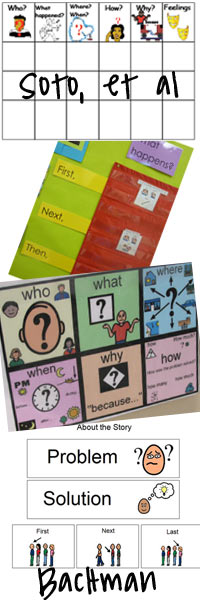
In either case, expectant pauses and generic follow-up prompts can be used to help the communicator expand their narrative (e.g., “Uh huh.” “Then what?” “Tell me more about that” “What else?”). Visual supports, such as the ones shown here, are enormously useful in narrative elicitation. Soto and her colleagues have also used photos of the communicators’ own lives to elicit personal narratives, but note that these should be action-oriented (e.g., baking cookies with a parent, playing in the ball pit with a sibling) rather than portrait-type photos.
Finally, for communicators who produce written work, we can also ask to see samples of any narratives they’ve written. School assignments and journals, for example, can give us some insight into the narrative skills of the communicator. We have to keep in mind, though, that often these written products were edited and revised following the input of a teacher or peer.
Analyzing the Narrative Sample
Much has been written about how to analyze narrative language, so we won’t try to recreate that here. Instead, we’ll talk about a few of the resources and tools that are particularly well-suited to people who use AAC and some of the considerations in using them with this clinical population. Depending on our reason for doing the narrative evaluation, we may choose to do a comprehensive analysis or focus more specifically on macrostructure or microstructure. In microstructure analysis, we look at the sample for information on lexical diversity, morpho-syntax, grammatical complexity, and cohesion. Since those are things we typically do as part of most language samples, we won’t talk much about them here. In macrostructure analysis, we’d go beyond that and look at things like story grammar, sequencing, and organization.
- Applebee’s 6 Levels of Narratives: Can be used for macroanalysis of personal and fictional narratives, but not scripts. The reference for the original work is below. It has been adapted by Becky Spivey here.
- Highpoint Analysis (Labov & Waletzky, 1967): Can be used for macroanalysis of personal narratives, but not a good fit for fictional or script narratives. Examines a structure in terms of its abstract, orientation, complicating action, evaluation, and resolution.
- Story grammar analysis (e.g., Mandler, 1982; Stein & Glenn, 1979): Can be used for macroanalysis of several types of narratives. Examines a structure in terms of setting, initiating event, characters’ internal response, problem-resolution (or attempts), outcomes and consequences, such as in this example.
- Narrative Assessment Profile (McCabe & Bliss, 2003): Can be used for macroanalysis of various narratives to examine topic maintenance, event sequencing, informativeness, referencing, conjunctive cohesion, and fluency, especially for individuals who don’t yet produce long narratives. You can read more about its application with AAC in this article by Soto and Hartmann.
- Test of Narrative Language (Gillam & Pearson, 2004): Can be adapted for people who use AAC and used for several types of narratives. Best for communicators with more advanced language skills who are producing longer narratives.
Looking at the results of a narrative assessment can tell us about where to go next in our language intervention. And that’s a good thing because better narrative skills impact social, cognitive, linguistic, and academic development. Are you facilitating narrative skills in people who use AAC? We’d love to hear about it!
::::::::::::::::::::::::::::::::::::::::::::::::::::::::::::::::::::::::::::::::::::::::::::::::::::::::::::::::::::::::::::::::::::::::::
Selected References on Narrative Assessment
- Applebee, A. (1978). The Child’s Concept of a Story: Ages 2-17. Chicago, IL: University of Chicago Press.
- Hughes, D., McGillivray, L., & Schmidek, M. (1997). Guide to Narrative Language: Procedures for Assessment. Eau Claire, WI: Thinking Publications.
- McCabe, A., & Bliss, L. S. (2003). Patterns of narrative discourse. Boston, MA: Allyn & Bacon.
- McCabe, A., & Rollins, P. R. (1994). Assessment of preschool narrative skills. American Journal of Speech-Language Pathology, 3, 45–56.
- Soto, G. & Hartmann, E. (2006). Analysis of narratives of four children who use augmentative and alternative communication. Journal of Communication Disorders, 39, 6, 456-480.
- Soto, G., Yu, B., Henneberry, S. (2007). Supporting the development of narrative skills of an 8 year-old child who uses an augmentative and alternative communication device: Case Study. Child Language Teaching and Therapy, 23, 27-45.
- Westby, C. (1984). Development of narrative language abilities. In G. Wallach & K. Butler (Eds.), Language learning disabilities in school-age children (pp. 103–127). Baltimore, MD: Williams & Wilkins.
Filed under: Strategy of the Month
Tagged With: analysis, assessment, narrative language, Scripts, stories, story grammar
This post was written by Carole Zangari


